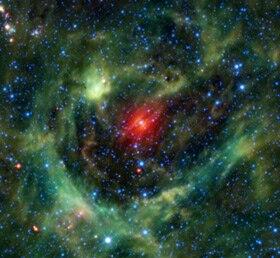Create a free profile to get unlimited access to exclusive videos, sweepstakes, and more!
A WISE Flower Blooms in the Sky

One of my favorite space missions is WISE: the Wide-field Infrared Survey Explorer, which mapped the entire sky in the far-infrared, well outside what our mere human eyes can see. At those wavelengths, objects we'd consider to be frigidly cold glow brightly. Those include clouds of dust and gas surrounding freshly-born stars, like the nebula called LBN 114.55 + 00.22:
You can see why I like WISE so much; the images it sent to Earth were spectacular! [Click to embiggen.] LBN 114 (for short) is a classic star-forming region. About 30 light years in diameter, itâs a dense clot of gas and dust, and in its core itâs busily churning out new stars. Some of these are massive, hot, blue stars, which blast ultraviolet light and also blow out a gale of subatomic particles, like the solar wind but far faster and stronger. The light and winds from these stars eats away at the inside of the cloud, carving a cavity in it.
You can actually see that in this image; the center of the nebula is dimmer, where the gas and dust have been pushed away. The overall effect makes LBN 114 look like a vast flower in spaceâthough one thatâs 300 trillion kilometers across.
You may have noticed the central part of the nebula is red. Why would that be if the stars lighting it up are blue? Thereâs more than one reason, but first, remember this is an infrared picture. What you see as red is actually way out in the infrared, at a wavelength of 22 microns (compare that to the reddest light the eye can see, at about 0.7 microns). Green is 12 microns, cyan is 4.6, and blue is 3.6 microns. As a rule of thumb, the cooler an object is, the redder the light it emits. So in WISE images the warmest objects are blue, and the coolest red.
Star birth regions like LBN 114 are choked with complex organic molecules called polycyclic aromatic hydrocarbons, or PAHs. Think of it as soot, which is pretty close to what it is! Warm interstellar dust tends to glow very strongly at around 12 microns, which is why you see so much frilly green material in images like this. Cooler dust emits at 22 microns, so it looks red in WISE images. You might expect that near the hot stars the dust would be even warmer, but things can get complicated. For example, some dust is laden with metals like magnesium and silicon, which help the dust cool off. This is pretty commonly seen in WISE images of objects like this (such as the Lambda Centauri Nebula, and the dust surrounding the star CY Camelopardalisâclick those for more beautiful WISE images).
As an aside, the bright star in the picture is called HIP 117078, a massive red supergiant near the end of its life. Itâs a long way off, 18,000 light years or so, three times farther than LBN 114. One day itâll explode, but probably not for a long timeâ¦and itâs too far away to hurt us here on Earth.
As you can see, this whole region of space is thick with dust, which absorbs visible light pretty well. Thereâs a lot of gas in this nebula, which glows strongly in visible light. However, in visible light this nebula is pretty faint when seen from Earth because all that dust in the way sucks down the light. At its distance of 6000 light years, LBN 114 is about half the size of the full Moon on the sky, yet itâs a relatively obscure object (I couldnât find much in the professional journals about it). If there were no dust in the way, it might be visible to the naked eye on a dark night.
And this is why we build observatories like WISE: to show us what we otherwise could not see. How can we possibly understand whatâs going in the Universe around us if weâre missing pieces of the puzzle? I wish we had a dozen observatories like WISE peering into the darkâ¦because at some wavelengths, the Universe isnât so dark. And we might not otherwise know.
Image credit: NASA/JPL-Caltech/WISE Team


























